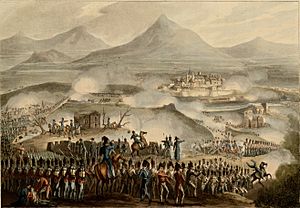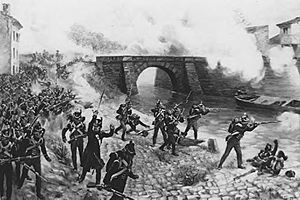Battle of Toulouse (1814) facts for kids
Quick facts for kids Battle of Toulouse |
|||||||
|---|---|---|---|---|---|---|---|
| Part of the Peninsular War | |||||||
 Panoramic view of the battle with allied troops in the foreground and a fortified Toulouse in the middle distance |
|||||||
|
|||||||
| Belligerents | |||||||
| Commanders and leaders | |||||||
| Strength | |||||||
| 42,430 | 49,446 | ||||||
| Casualties and losses | |||||||
| 321 killed 2,369 wounded |
593 killed 5,024 wounded |
||||||
The Battle of Toulouse happened on April 10, 1814. It was one of the very last battles of the Napoleonic Wars. This battle took place just four days after Napoleon gave up his power as leader of the French Empire.
The Duke of Wellington led an army of British, Portuguese, and Spanish soldiers. They had been fighting hard to push the French army out of Spain. Now, they were fighting inside southern France.
Toulouse was a city strongly defended by Marshal Soult of France. The fighting on April 10 was tough. Many Allied soldiers were hurt. Soult kept the city for one more day. Then, he managed to escape with his army. He left behind about 1,600 wounded soldiers.
On April 12, Wellington entered Toulouse. Many French people who supported the king were happy to see him. Later that day, news arrived that Napoleon had given up his throne. This meant the war was finally over. Soult agreed to stop fighting on April 17.
Contents
Why the Battle of Toulouse Happened
After successfully entering France, the Allied army moved towards Toulouse. This city was one of the last places in France still loyal to Napoleon. The Allied army included soldiers from Britain, Portugal, and Spain. Their main commander was Field Marshal Arthur Wellesley, Marquess of Wellington.
About 42,000 French troops defended Toulouse. They were led by Marshal Jean-de-Dieu Soult. The French soldiers were tired and losing hope. They had been fighting the Allied forces in their own country. News of Napoleon's defeats in other parts of France also made them feel worse.
The Allied forces had slowly pushed the French out of Spain during 1813. This was after many years of guerrilla warfare (small, surprise attacks). These fights had caused over 300,000 French soldiers to be lost. Napoleon had also moved many soldiers from southern France to fight in the north and east. This happened after a big Allied victory at Leipzig in October 1813.
Getting Ready for Battle
After the Battle of Orthez
In February 1814, Wellington defeated Soult at the Battle of Orthez. Soult's army then moved north behind the river Adour. Soult had a difficult choice. He could defend Bordeaux or Toulouse, but not both. It would be hard to get food near Bordeaux. Also, the river Garonne would be behind his army there. So, Soult decided to defend Toulouse.
Taking Bordeaux
Since Soult moved east, Wellington sent Beresford and two divisions to take Bordeaux. Bordeaux was the third-largest city in France. To make up for the soldiers he sent away, Wellington called for 8,000 Spanish soldiers and British cavalry. Wellington paid and supplied his Spanish allies. He worried they might cause trouble in the French countryside.
On March 12, Beresford captured Bordeaux without a fight. He left some soldiers there and rushed back to join Wellington. Meanwhile, Wellington started his main attack. He hoped to trap Soult's army. But the French army marched quickly to Toulouse. They avoided Wellington's circling troops. Once in Toulouse, Soult put his soldiers behind the city's strong walls.
Setting Up the Attack
On April 4, Wellington's engineers built a temporary bridge across the Garonne River. This was north of Toulouse. About 19,000 Allied soldiers crossed. But then the bridge broke, trapping the soldiers for three days. Soult did not use this chance to attack them.
On April 8, British soldiers on horseback, the 18th Hussars, captured a bridge on the Hers River. Meanwhile, on April 7, official messengers left Paris. They carried news that Napoleon had given up his power. This meant the war was over.
French Defenses of Toulouse
Toulouse is located on the Garonne River. The river flows into the city from the southwest and leaves to the northwest. East of the Garonne, a smaller river, the Hers-Mort, runs past the city. This creates a narrow path. To attack from the north, Wellington's army had to cross the Garonne. Then they would march southeast between the two rivers.
West of the Garonne was a fortified area called St-Cyprien. To the north, Soult's outer defense line was along the Languedoc Canal. Three bridges crossed this canal. Each bridge had a strong fort protecting it. East of the city were the Heights of Calvinet. These hills had several forts on top. Soult placed his soldiers carefully to defend all these points.
The Battle Begins
Wellington started his attack on Easter Sunday, April 10. He sent General Hill with 12,600 soldiers to attack St-Cyprien. This was meant to distract some of Soult's forces. The rest of Wellington's army, about 36,000 men, attacked east of the Garonne.
Wellington planned his main effort against the Heights of Calvinet. General Beresford would lead two divisions and cavalry down the Hers River. Once he was east of the city, Beresford would turn west. He would then attack the Heights. At the same time, General Freire would attack the northern part of the Heights with his Spanish soldiers.
First Attacks
To the west, General Hill pushed back the French guards. But the fighting there was not very serious. His soldiers had about 80 casualties. General Thomas Picton attacked the Pont Jumeaux bridge with his division. He was pushed back and lost 400 soldiers.
Meanwhile, Beresford's soldiers had trouble moving through muddy fields. They fell behind schedule. They couldn't move their cannons. So, Beresford ordered the cannons to fire from a distance. General Freire thought this was the signal to attack. He sent his Spanish soldiers to charge the Heights. The Spanish soldiers fought their way uphill. But French soldiers quickly counter-attacked. The Spanish were forced to run away. They regrouped and attacked again, but were defeated a second time.
Taking the Heights
Finally, Beresford's two divisions reached their starting positions. The 6th Division led the way. A French division attacked them, but was easily pushed back uphill. British rockets caused confusion among the French soldiers. The Allied divisions began to move up the slope. They fought hard to reach the top of the Heights.
Once at the top, they paused to bring up some cannons. They then moved north, breaking through the French defenses. Beresford's men captured two forts. They lost them in a French counter-attack. But they finally took them back after bringing up more soldiers. With the Heights lost, Soult pulled his soldiers back behind the city's walls.
Soult held Toulouse on April 11. But he decided to leave the city when he saw Allied cavalry moving on the road to Carcassonne. At 9 pm that evening, the French army left Toulouse.
After the Battle
On the morning of April 12, city officials gave Toulouse over to the Allied army. That afternoon, Wellington received news that Napoleon had given up his throne. A few hours later, official messengers from Paris confirmed this. Wellington immediately sent the news to Soult.
Soldier Losses
The Allied army lost 4,558 soldiers. This included 1,900 from Freire's Spanish divisions and 1,500 from the 6th Division. The French army lost 231 officers and 3,005 men.
Stopping the Fighting
On April 13, Marshal Soult was marching his army when officers from Paris caught up to him. They told him Napoleon had given up. But Soult said he wasn't sure if their news was real. He refused to accept the new government until he had strong proof.
Wellington sent Soult a message on April 14. He said there would be no peace until Soult accepted the new government. People thought Soult might want to keep his army ready for Napoleon. But on April 15, another French Marshal, Marshal Suchet, accepted the news. He asked Wellington for a ceasefire.
The last major fight of the war happened on April 14 at the Battle of Bayonne. The French commander led an attack from the city against the Allied lines.
On April 17, Soult finally received a message from Berthier. This message officially announced Napoleon's abdication. It also said that fighting should stop everywhere. There was nothing more to do. That same day, Soult's chief officer went to Toulouse to sign a ceasefire. This ended the fighting in the south. The city was briefly controlled by the Allied forces. Allied troops left in September 1814.
See also
 In Spanish: Batalla de Toulouse para niños
In Spanish: Batalla de Toulouse para niños


